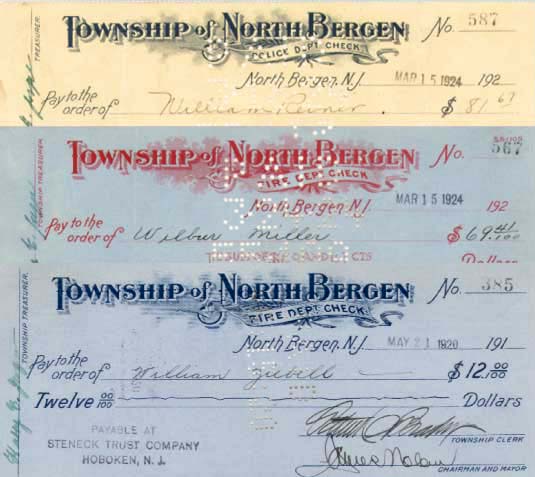Township of North Bergen - Set of 3 Checks
Inv# CK1045 Check
Drawn on Steneck Trust Co., Hoboken, NJ. Set of 3 checks, 2 fire department and 1 police department. Fire department checks on blue paper. Set of 3 checks or individuals.
North Bergen is a township in the northern part of Hudson County, New Jersey, United States. As of the 2010 United States Census, the township had a total population of 60,773, reflecting an increase of 2,681 (+4.6%) from the 58,092 counted in the 2000 Census, which had in turn increased by 9,678 (+20.0%) from the 48,414 counted in the 1990 Census. The town was founded in 1843. It was much diminished in territory by a series of secessions. Situated on the Hudson Palisades, it is one of the "hilliest" municipalities in the United States. Like neighboring North Hudson communities, North Bergen is among those places in the nation with the highest population density and a majority Hispanic population.
At the time of European colonization the area was the territory of Hackensack tribe of the Lenape Native Americans, who maintained a settlement, Espatingh, on the west side of the hills. and where a Dutch trading post was established after the Peach Tree War. In 1658, Peter Stuyvesant, then Director-General of New Netherland, repurchased from them the area now encompassed by the municipalities of Hudson County east of the Hackensack River. In 1660 he granted permission to establish the semi-autonomous colony of Bergen, with the main village located at today's Bergen Square, considered to be the first chartered municipality in what would become the state of New Jersey. At the time, the area of North Bergen was heavily forested, traversed by paths used by the indigenous and colonizing population and became known as Bergen Woods, a name recalled in today's neighborhood of Bergenwood.
After the 1664 surrender of Fort Amsterdam the entire New Netherland colony came into the possession of the British, who established the Province of New Jersey. In 1682, the East Jersey legislature formed the state's first four counties, including Bergen County, which consisted of all the land in the peninsula between the Hackensack and Hudson Rivers; that is, the eastern portions of what today is Bergen and Hudson Counties. In 1693, Bergen County was divided into two townships: Hackensack Township in the north, and Bergen Township, encompassing the Bergen Neck peninsula, in the south. The border between the two townships is the current Hudson-Bergen county line.
While settlement was sparse, communities developed along the Bergen Turnpike at the Three Pigeons and Maisland, later New Durham. French botanist André Michaux developed his gardens nearby. On the Hudson River, Bulls Ferry became an important landing for crossings to Manhattan. While ostensibly under British control during the American Revolutionary War, the area was patrolled by the Americans on foraging, espionage, and raiding expeditions; most notably the Battle of Bull's Ferry.










Ebay ID: labarre_galleries